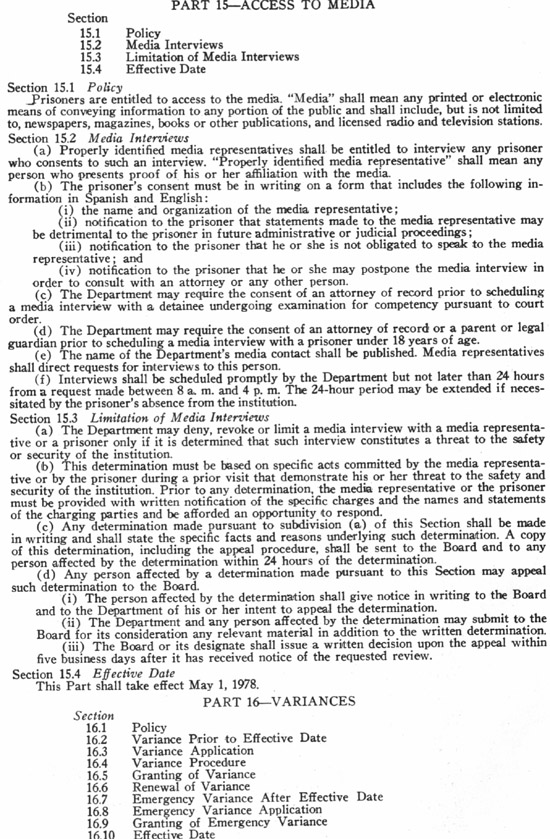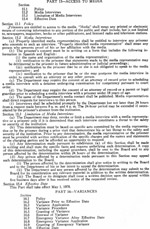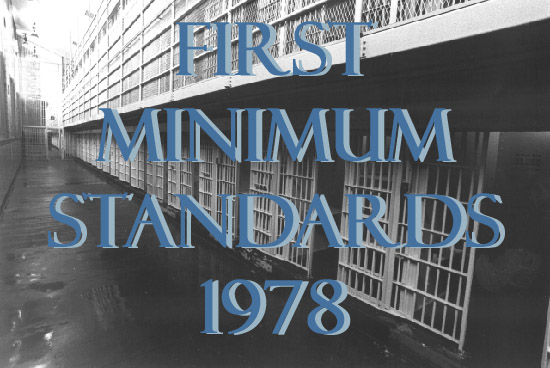|
PART 15 -- ACCESS TO MEDIA
| Section |
| 15.1 | Policy |
| 15.2 | Media Interviews |
| 15.3 | Limitation of Media Interviews |
| 15.4 | Effective Date |
Section
15.1 Policy
Page 16 of 1978 Minimum Standards.

Above is an image of Page 16 of the first publication (1978) of the Minimum Standards for New York City Correctional Facilities issued by the NYC Board of Correction, as given to NYCHS by former NYC DOC photographer Mark Mellett. NYCHS appreciates this and other archival material Mark Mellett has generously donated.
Click on the above image to bring up a larger JPG version (at the bottom of which is a link to click to return here).
 Left is another image of Page 16 of the first publication (1978) of the Minimum Standards. Click on it to access an Adobe Acrobat (PDF) downloadable and printable scanned copy (1 Mb) of the original Page 16.
Use your browser's "back" button to return to this page in order to navigate through the rest of this presentation.
|
|
Prisoners are entitled to access to the media. "Media" shall mean any printed or electronic means of conveying information to any portion of the public and shall include, but is not limited to, newspapers, magazines, books or other publications, and licensed radio and television stations
Section
15.2 Media Interviews
(a) Properly identified media representatives shall be entitled to interview any prisoner who consents to such an interview. "Properly identified media representative" shall mean any person who presents proof of his or her affiliation with the media.
(b) The prisoner's consent must be in writing on a form that includes the following information in Spanish and English:
- the name and organization of the media representative;
- notification to the prisoner that statements made to the media representative may be detrimental to the prisoner in future administrative or judicial proceedings;
- notification to the prisoner that he or she is not obligated to speak to the media representative; and
- notification to the prisoner that he or she may postpone the media interview in order to consult with an attorney or any other person.
(c) The Department may require the consent of an attorney of record prior to scheduling a media interview with a detainee undergoing examination for competency pursuant to court order.
(d) The Department may require the consent of an attorney of record or a parent or legal guardian prior to scheduling a media interview with a prisoner under 18 years of age.
(e) The name of the Department's media contact shall be published. Media representatives shall direct requests for interviews to this person.
(f) Interviews shall be scheduled promptly by the Department but not later than 24 hours from a request made between 8 a. m. and 4 p. m. The 24-hour period may be extended if necessitated by the prisoner's absence from the institution.
Section
15.3 Limitation of Media Interviews
(a) The Department may deny, revoke or limit a media interview with a media representative or a prisoner only if it is determined that such interview constitutes a threat to the safety or security of the institution.
(b) This determination must be based on specific acts committed by the media representative or by the prisoner during a prior visit that demonstrate his or her threat to the safety and security of the institution. Prior to any determination, the media representative or the prisoner must be provided with written notification of the specific charges and the names and statements of the charging parties and be afforded an opportunity to respond.
(c) Any determination made pursuant to subdivision (a) of this Section shall be made in writing and shall state the specific facts and reasons underlying such determination. A copy of this determination, including the appeal procedure, shall be sent to the Board and to any person affected by the determination within 24 hours of the determination.
(d) Any person affected by a determination made pursuant to this Section may appeal such determination to the Board.
Return-to-List Icon.

If you wish to go back to the Parts List on Page 1 instead of proceeding forward, click the above icon.
|
|
- The person affected by the determination shall give notice in writing to the Board
and to the Department of his or her intent to appeal the determination.
- The Department and any person affected by the determination may submit to the
Board for its consideration any relevant material in addition to the written determination.
- The Board or its designate shall issue a written decision upon the appeal within
five business days after it has received notice of the requested review.
Section
15.4 Effective Date
This Part shall take effect May 1, 1978.
PART 16 -- VARIANCES
| Section |
| 16.1 | Policy |
| 16.2 | Variance Prior to Effective Date |
| 16.3 | Variance Application |
| 16.4 | Variance Procedure |
| 16.5 | Granting of Variance |
| 16.6 | Renewal of Variance |
| 16.7 | Emergency Variance After Effective Date |
| 16.8 | Emergency Variance Application |
| 16.9 | Granting of Emergency Variance |
| 16.10 | Effective Date |
| 

